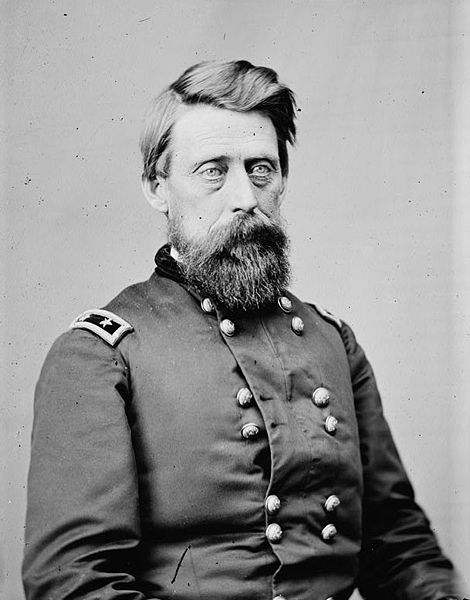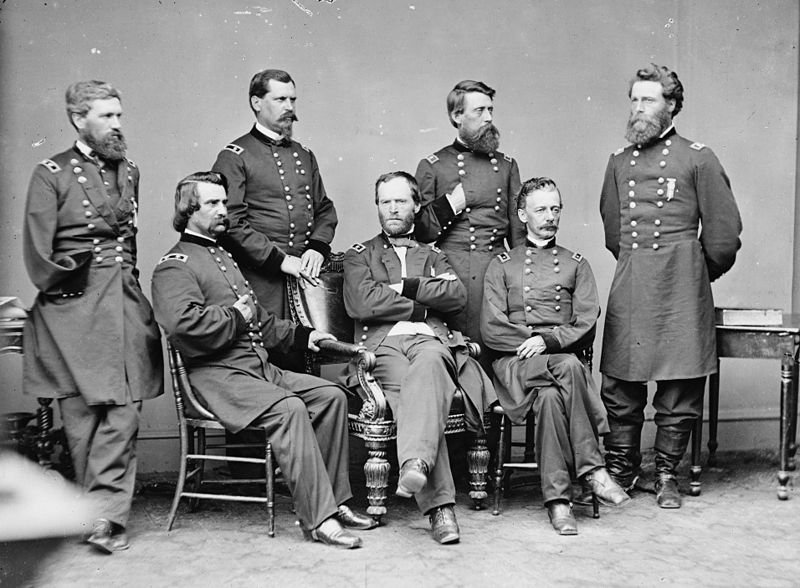<Back to Index>
- Brigadier General of the U.S. Army Jefferson Columbus Davis, 1828
PAGE SPONSOR


Jefferson Columbus Davis (March 2, 1828 – November 30, 1879) was an officer in the United States Army who served in the Mexican - American War, the Civil War and the Modoc War. He was the first commander of the Department of Alaska, from 1868 to 1870. Although successful in a number of Civil War battles, he is best remembered for two attributes: the similarity of his name to that of Confederate President Jefferson Davis and his murder of a superior officer during an argument in the Civil War.
Davis was born near present day Memphis, Indiana. He joined the 3rd Indiana Volunteers in June 1846 and served as an enlisted volunteer during the Mexican - American War, rising to the rank of sergeant. Upon completion of his volunteer service in June 1848, he was commissioned a second lieutenant in the 1st Artillery Regiment. He was promoted to first lieutenant in February 1852.
At the start of the American Civil War, Davis was serving in the Fort Sumter garrison when it was bombarded by Confederate forces in April 1861. The following month he was promoted to captain, and in August Davis became colonel of the 22nd Indiana Infantry, which he led in the Battle of Wilson's Creek. In December 1861, he became brigadier general of volunteers, commanding the 3rd Division, Army of the Southwest, at the Battle of Pea Ridge. He commanded the 4th Division, Army of the Mississippi, at Corinth. He went on sick leave, but left his hospital bed to serve in the defenses of Cincinnati, Ohio.
During this time of convalescence, on September 29, 1862, Davis got into an argument with his superior officer, Maj. Gen. William "Bull" Nelson, in the Galt House in Louisville, Kentucky. Davis had been offended by insults on prior occasions and when his face was slapped by Nelson, Davis shot and killed him. He was arrested and imprisoned, but Maj. Gen. Horatio G. Wright came to his aid and was able to get him released from prison. He avoided conviction for the murder because there was a need for experienced field commanders in the Union Army.
Davis was a capable commander, but because of the murder of General Nelson, he never received a full promotion higher than brigadier general of volunteers. He did however receive a brevet promotion to major general of volunteers on August 8, 1864 (for his service at the Battle of Kennesaw Mountain), and was appointed commanding officer of the XIV Corps during the Atlanta Campaign, a post he retained until the end of the war. He received a brevet promotion to brigadier general in the regular army on March 20, 1865.
However, it was his actions during the Ebenezer Creek passing and his racist attitude towards freed slaves, that causes his legacy to be clouded in continued controversy. As Sherman's army proceeded on the March to the Sea toward Savannah, Georgia, on December 9, 1864, Davis ordered a pontoon bridge removed before the African - American refugees following his corps could cross the creek. Several hundred were captured by the Confederate cavalry or drowned in the creek, attempting to escape.
After the Civil War, Davis continued service with the Army, being appointed colonel of the 23rd Infantry Regiment in July 1866. He was the first commander of the Department of Alaska, from March 18, 1868, to June 1, 1870. During this time, he ordered Russian residents of Sitka, Alaska, to leave their homes, as he maintained that they were needed for Americans.
He gained fame when he assumed field command of the U.S. forces during the Modoc War, after General Edward Canby and Rev. Eleazer Thomas had been assassinated during peace talks. His presence in the field restored the confidence of the soldiers after their recent setbacks against the Modoc. Davis' campaign resulted in the Battle of Dry Lake and the eventual surrender of notable leaders such as Hooker Jim and Captain Jack.
Davis died in Chicago, Illinois, and is buried in Crown Hill Cemetery, Indianapolis, Indiana.